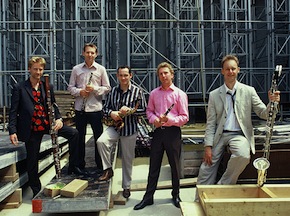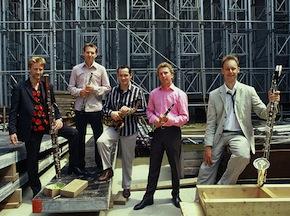
Visiting from Amsterdam in a concert for the San Jose Chamber Music Society, the Calefax Quintet interrupted audience chatter to open the second half, strolling into Le Petit Trianon from the house doors (in the back of the hall) while playing the opening Aria to Bach’s Goldberg Variations from memory. It was less an entrance march than a gentle-footed exploration of the hall’s lively acoustic. Instead of being awed into silence, some in the crowd ignored this glorious sound and continued with their chitchat.
The Quintet made its way to the stage and proceeded to play its own arrangement of the 32 variations (originally for harpsichord) for oboe/oboe d’amore, saxophone, bassoon, bass clarinet, and clarinet. When divided among five reeds, the variations take on a life of their own. Every little arpeggio can get a dedicated swell and taper, while every little appoggiatura receives a pained sigh. Sometimes variations were set as a duet between two clarinets, at other times as a conversation between bassoon and oboe, or perhaps in a spot for the saxophone to show off its Baroque viability.
Saxophonist Raaf Hekkema proved that his instrument is capable of amazingly sweet and gentle textures rather than the brash sound that it’s notorious for. During the recital, practically all the available instrument combinations were explored, but the full quintet sound was saved for significant structural points in the composition. The overture in the exact center of the piece, for example, was a stunning display of the sheer volume that these instruments can generate merely with the human breath. Still, my ear yearned for a crisper articulation in the boomy, box-shaped hall, and welcomed the lively attack from Jelte Althuis’ bass clarinet. Over and over again his bass line provided a joyous bounce for the ensemble.
The Quintet passed around motives with unpredictable speed, as in a blurry game of squash. Some of the runs, difficult as they are on the keyboard, proved a little awkward on what are essentially perforated tubes. At daringly fast tempos, some of the notes were lost in a jumble of squeaks and key clicks. The Quintet played the recap of the original aria from memory, as well, turning away from their semicircle of music stands to face the audience in a subtle yet moving change of staging.
True to Bach
Much of Bach’s best music for oboe is tucked into the multitude of his cantatas and Passions. Hearing the variations on reeds conjured the sounds of those religious works — a testament to Bach’s consistency of style. Whether he’s composing settings of Luther’s Bible or setting abstract instrumental counterpoint, his arpeggiation patterns, bass-line shapes, and harmonic progressions are always true to form.
When divided among five reeds, the variations take on a life of their own.
For some reason, the great composers didn’t write as much chamber music for winds as they did for strings. Perhaps they thought woodwind technique wasn’t agile enough or versatile enough to achieve their envisioned sound color. With a relatively limited repertoire intended for this combination of instruments, the Calefax Quintet took matters into its own hands, borrowing from the piano literature.
One great thing about music is that the lender is no poorer for lending out the material: The original music is still there in its purity, while a half-new piece is created in the new arrangement. Bach would likely have approved of this practice, as he himself used music for violin and organ almost interchangeably. Many composers originally work out of piano reductions before orchestrating their music in various instrumentations.
It was a luxury to hear them in such artistic hands in this unusual instrumentation.
Calefax’s Hekkema was responsible for arranging the Bach as well as the Grieg’s Holberg Suite and bassoonist Oliver Boekhoorn arranged Debussy’s Suite Bergamasque. Arranging involves copying the original note and assigning it to an instrument in parts that make melodic sense and lie well on the instrument. This tedious but rewarding process gives the arranger an intimate knowledge of the music, in a sort of communion with the composer. When the arranger is also a performer, this inner understanding does wonders for interpretation. That was certainly evident in this performance, for the contrapuntal lines were as clear as I have ever heard them.
Winds can play swells amazingly well. Certainly, the bow can generate a swell, and string players can bow back and forth to make an endless note. But with a wider dynamic range than strings, and breath that can last longer than a single bow stroke, the Calefax achieved some stunning phrasing. Debussy’s oceanlike swells were prime examples of this. The Grieg also contained some breathtaking, hairpin swells. It was a luxury to hear them in such artistic hands in this unusual instrumentation.
The overall theme of the program was Baroque form: preludes, canons, and dance forms such as gavottes, jigs, and airs. These dances were not intended for literal dancing, except by the most artsy choreographers. Rather, they’re dances for the fingers up and down the dance floor that is the grand musical staff.
As an encore, the Quintet played a song by Eunice Kathleen Waymon (aka Nina Simone) based on the “Goldberg” progression. Raaf Hekkema finally got to show off the saxophone’s jazzy side in an impassioned good-bye.

